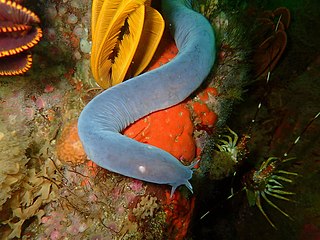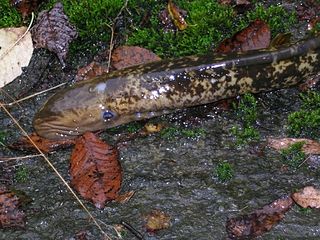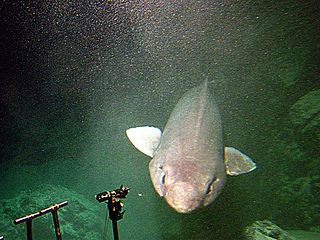
Hagfish, of the class Myxini and order Myxiniformes, are eel-shaped jawless fish. Hagfish are the only known living animals that have a skull but no vertebral column, although they do have rudimentary vertebrae. Hagfish are marine predators and scavengers who can defend themselves against other larger predators by releasing copious amounts of slime from mucous glands in their skin.

The ribbon eel, also known as the leaf-nosed moray eel or bernis eel, is a species of moray eel, the only member of the genus Rhinomuraena. The ribbon eel is found in sand burrows and reefs in the Indo-Pacific Ocean. Although generally placed in the moray eel family Muraenidae, it has several distinctive features leading some to place it in its own family, Rhinomuraenidae.

Pelagic fish live in the pelagic zone of ocean or lake waters—being neither close to the bottom nor near the shore—in contrast with demersal fish that live on or near the bottom, and reef fish that are associated with coral reefs.

Cyclostomi, often referred to as Cyclostomata, is a group of vertebrates that comprises the living jawless fishes: the lampreys and hagfishes. Both groups have jawless mouths with horny epidermal structures that function as teeth called ceratodontes, and branchial arches that are internally positioned instead of external as in the related jawed fishes. The name Cyclostomi means "round mouths". It was named by Joan Crockford-Beattie.

Eptatretus springeri, the Gulf hagfish, is a bathydemersal vertebrate which lives primarily in the northeastern Gulf of Mexico. It has been observed feeding at and around brine pools: areas of high salinity which resemble lakes on the ocean floor that do not mix with the surrounding water due to difference in density. The high salt content, approximately 200 ppt compared to 35 ppt for standard seawater, creates a buoyant surface which renders oceanic submersibles unable to descend into the pool. It is believed that the inside of the pools only supports microbial life, while the majority of macroscopic life, such as methane-utilizing mussels, exists on the edges. The Gulf hagfish feeds on the primary producers of these environments, as well as other predators.
The snubnosed eel, Simenchelys parasitica, also known as the pug-nosed eel, slime eel, or snub-nose parasitic eel, is a species of deep-sea eel and the only member of its genus. Some authors classify it as the sole member of the subfamily Simenchelyinae of the family Synaphobranchidae, or cutthroat eels, while others place it in its own monotypic family, the Simenchelyidae. It is found in the Atlantic and Pacific Oceans, typically at a depth of 500–1,800 m (1,600–5,900 ft) near the bottom. Although typically a scavenger, it is better known for using its powerful jaws and teeth to burrow into larger fishes as a parasite. This species is harmless to humans and of no interest to fisheries. The generic name Simenchelys translates literally as "pug-nosed eel".

The broadgilled hagfish or New Zealand hagfish, also known by its Māori language name tuere, is a hagfish found around New Zealand and the Chatham Islands as well as around the south and east coasts of Australia, at depths between 1 and 900 metres.

The false catshark or sofa shark is a species of ground shark in the family Pseudotriakidae, and the sole member of its genus. It has a worldwide distribution, and has most commonly been recorded close to the bottom over continental and insular slopes, at depths of 500–1,400 m (1,600–4,600 ft). Reaching 3.0 m (9.8 ft) in length, this heavy-bodied shark can be readily identified by its elongated, keel-like first dorsal fin. It has long, narrow eyes and a large mouth filled with numerous tiny teeth. It is usually dark brown in color, though a few are light gray.

The Pacific hagfish is a species of hagfish. It lives in the mesopelagic to abyssal Pacific Ocean, near the ocean floor. It is a jawless fish and has a body plan that resembles early Paleozoic fish. They are able to excrete prodigious amounts of slime in self-defense.

Eptatretus is a large genus of hagfish.

Spawn is the eggs and sperm released or deposited into water by aquatic animals. As a verb, to spawn refers to the process of freely releasing eggs and sperm into a body of water ; the physical act is known as spawning. The vast majority of aquatic and amphibious animals reproduce through spawning. These include the following groups:

Stemonidium hypomelas is a species of deep-sea eel in the family Serrivomeridae, originally described from a 171 mm (6.7 in) specimen taken from a depth of around 1,000 m (3,280 ft) near Niihau Island, Hawaii in 1902. It can be distinguished from the related sawtooth eels by its reduced dentition, which more resemble those of the snipe eel. It is of no significance to fisheries.

The inshore hagfish is a hagfish found in the Northwest Pacific, from the Sea of Japan and across eastern Japan to Taiwan. It has six pairs of gill pouches and gill apertures. These hagfish are found in the sublittoral zone. They live usually buried in the bottom mud and migrate into deeper water to spawn. The inshore hagfish is the only member of the Myxinidae family having a seasonal reproductive cycle.
Eptatretus bischoffii is a common hagfish of the genus Eptatretus. Its maximum length is 55 centimetres (22 in). It lives in a demersal, non-migratory, marine habitat with its depth range between 8–50 m. It can survive in only temperate zones. These organisms are found in the South Pacific, mainly, Chile. It is harmless to humans.

Myxine glutinosa, known as the Atlantic hagfish in North America, and often simply as the hagfish in Europe, is a species of jawless fish of the genus Myxine.
Notomyxine is a monospecific genus of hagfish that occurs in the Atlantic Ocean off the southern coasts of South America. The only member of the genus is Notomyxine tridentiger. It can be found in the temperate waters of the Southeast Pacific and Southwest Atlantic, as well as the southern coasts of South America. It can reach a maximum length of 57 cm.

Bathypterois is a genus of deepsea tripod fishes. They are a diverse genus that belong to the greater family Ipnopidae and order Aulopiformes. They are distinguished by having two elongated pelvic fins and an elongated caudal fin, which allow them to move and stand on the ocean floor, much like a tripod, hence the common name. Bathypterois are distributed worldwide with some particular species of the genus having specialized environmental niches, such as lower dissolved oxygen concentrations. Bathypterois have a reduced eye size, highly specified extended fins, and a mouth adapted to filter feeding. They are filter feeders whose main food source is benthopelagic planktonic calanoid copepods, but some variation is seen with maturity in secondary food sources. Bathypterois use their three elongated fins for a wide range of motion from landing to standing on the ocean floor to catching prey, for which these fins serve as specialized perceptory organs. Bathypterois have both male and female gonads at once making, them simultaneous hermaphrodites, whose gonads go through five stages of development following seasonal autumn spawning.

Fish go through various life stages between fertilization and adulthood. The life of fish start as spawned eggs which hatch into immotile larvae. These larval hatchlings are not yet capable of feeding themselves and carry a yolk sac which provides stored nutrition. Before the yolk sac completely disappears, the young fish must mature enough to be able to forage independently. When they have developed to the point where they are capable of feeding by themselves, the fish are called fry. When, in addition, they have developed scales and working fins, the transition to a juvenile fish is complete and it is called a fingerling, so called as they are typically about the size of human fingers. The juvenile stage lasts until the fish is fully grown, sexually mature and interacting with other adult fish.

Eptatretus hexatrema, the sixgill hagfish, or snotslang is a species of marine fish in the hagfish family of order Myxiniformes. It is native to the South Atlantic Ocean and southwestern Indian Ocean.

Congrogadus is a genus of ray-finned fishes, the type genus of the subfamily Congrogadinae, the eel blennies, part of the dottyback family, Pseudochromidae. The genus Congrogadus has an Indo-Pacific distribution.

















